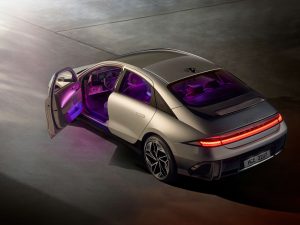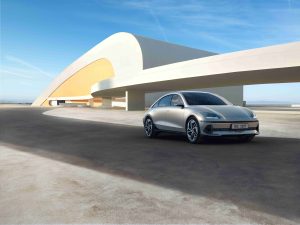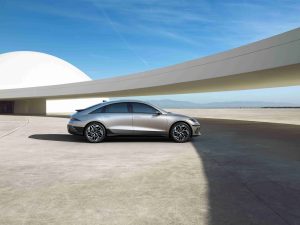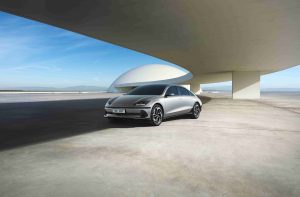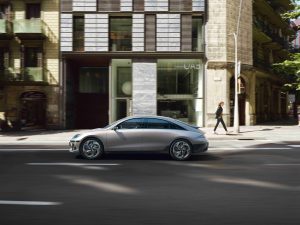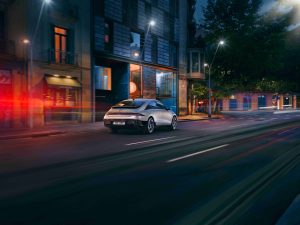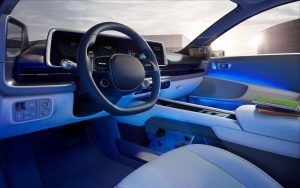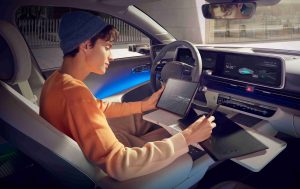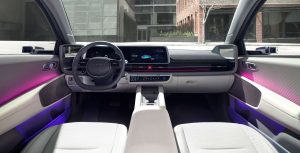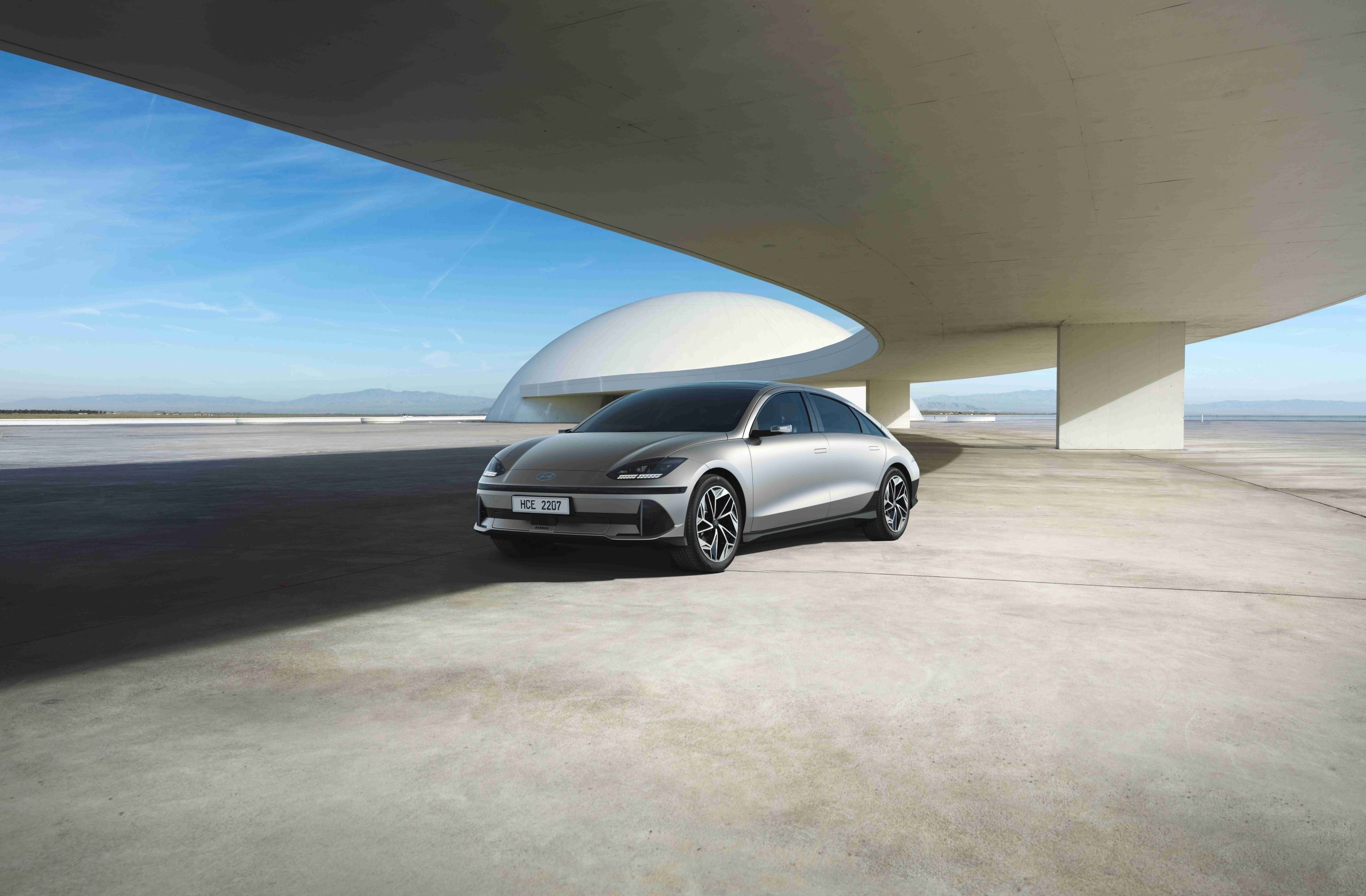
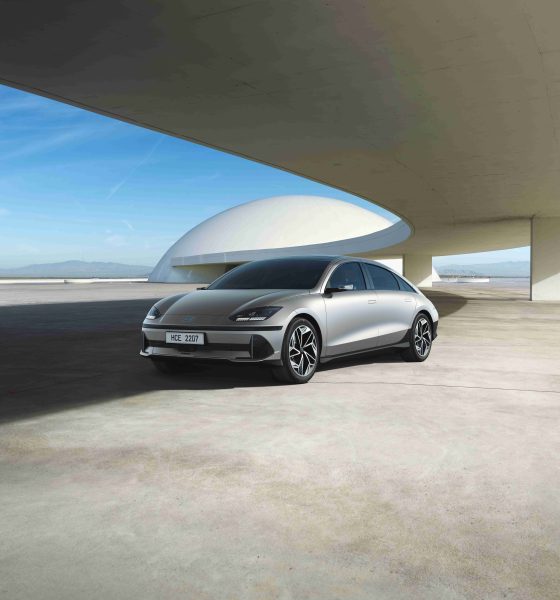
News
Hyundai Ioniq 6 electric sedan unveiling: 340-mile range, 320 horsepower, 77.4kWh battery
Hyundai has unveiled its new all-electric sedan, the Hyundai Ioniq 6.
The Hyundai Ioniq 6 made its first appearance earlier this year, and now the vehicle will be coming to the U.S. in the spring of next year. Today’s unveiling at the LA Auto Show included numerous details about the model coming to the U.S. There is a lot to be excited about.
First of all, the Hyundai Ioniq 6 offers some impressive technical specifications. The sedan has either a single-motor rear-wheel-drive or a dual-motor all-wheel-drive system. The model with the single-motor rear-wheel-drive setup produces a respectable 225 horsepower and 258 pound-feet of torque. While with the Ioniq 6’s optional AWD system, customers get 320 horsepower and 446 pound-feet of torque. An impressive amount of power that will rocket the family sedan from 0-60 in under 5 seconds.
- Credit: Hyundai
Both drivetrains are powered by a 77.4kWh battery that gives the aerodynamic sedan a range of up to 340 miles. And charging the battery will be no problem either, charging from 10-80% in 18 minutes. Sadly, the smaller 53kWh battery sold in other markets will not be available in the U.S. Hyundai didn’t specify an MSRP for any of the upcoming trims at the launch event today.
Outside of just the drivetrain, the Ioniq 6 has a myriad of features, such as vehicle-to-load capability, over-the-air updates, and numerous charge ports sprinkled throughout the cabin to keep your devices topped off.
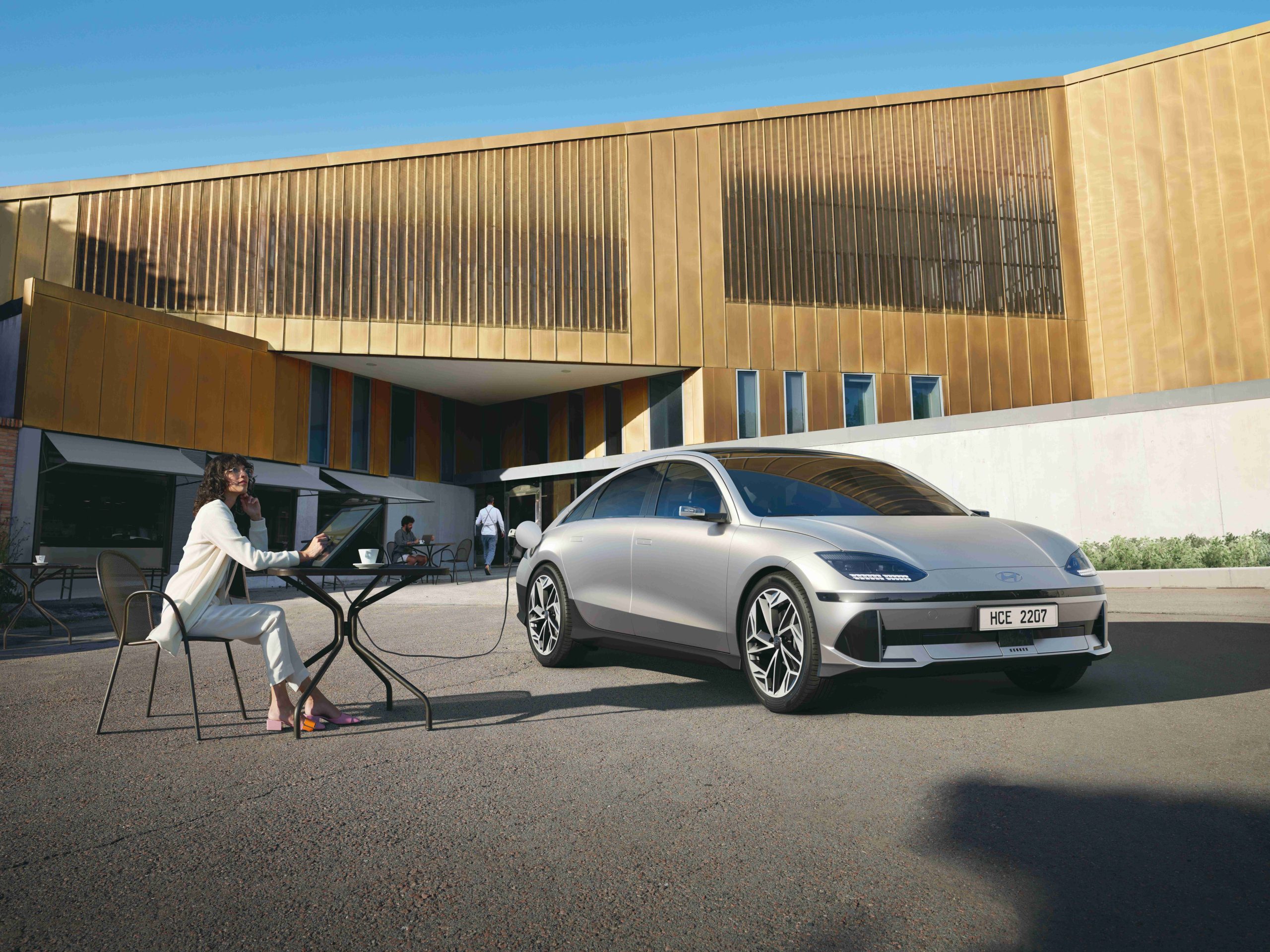
The Hyundai Ioniq 6 has nearly identical specifications to its larger sibling, the Hyundai Ioniq 5, because both vehicles are built on the same “E-GMP” platform. However, with the improved aerodynamics of the Ioniq 6 (a drag coefficient of 0.22), customers have access to increased range with the same battery system.
While impressive, the specifications of the vehicle were not the focus of the unveiling today. Presenters focused on the numerous design elements of the new car and how they affect the occupants’ experience. “We want our cars to always connect with customers on an emotional level,” said SangYup Lee, executive vice president and head of Hyundai Design Center.
First, the sedan’s interior space was a central focus point. Hyundai specifically outlined the significant legroom and width found within the new car. Body panels have been compressed to allow maximum interior space, while the ambient lighting system makes the already spacious cabin feel even more extensive.
The lighting system wasn’t only a selling point for the interior space. Much like the active sound design, the ambient lighting can be set to brighten and dim as the vehicle accelerates and decelerates, only furthering the feeling of speed.
Lighting was also a focus on the exterior design of the Ioniq 6. Hyundai has created a unique design language using square lights, most prominently seen on the headlights and taillights of both the Ioniq 6 and Ioniq 5. These “pixels,” as Hyundai calls them, are added to the top of the Hyundai Ioniq 6’s functional rear wing, and even make their way inside as part of driver-focused U/I elements.
Finally, Hyundai stressed the sustainability focus of its design. Not only was the company dedicated to using “earth-friendly materials,” but it also emphasized that the aerodynamic shape added to the product’s sustainability, helping consumers charge less often and use less energy in their transportation.
In his concluding statements, José Muñoz, president and CEO of Hyundai Motor North America, stated, “[the] Ioniq 6 fits the image, efficiency, and sportiness that many owners desire. Ioniq 6 and its interior space, battery options, charging speed, and all-wheel drive capability will exceed customer expectations.”
After introducing the Ioniq 6 in the spring of next year, it will eventually be produced at Hyundai’s new Georgia-based EV production facility along with numerous other planned products, such as the Hyundai Ioniq 7 full-size SUV that will be coming in 2024.
It is clear that Hyundai has found success with its uniquely designed electric vehicles, and many are looking forward to their Ioniq 6 reservation being filled. It will certainly be an exciting day when the Ioniq 6 finally hits the roads of North America.
Photo Credit: Hyundai Motors North America
What do you think of the article? Do you have any comments, questions, or concerns? Shoot me an email at william@teslarati.com. You can also reach me on Twitter @WilliamWritin. If you have news tips, email us at tips@teslarati.com!

News
Tesla hints at Starlink integration with recent patent
“By employing polymer blends, some examples enable RF transmission from all the modules to satellites and other communication devices both inside and outside the vehicle.”

Tesla hinted at a potential Starlink internet terminal integration within its vehicles in a recent patent, which describes a vehicle roof assembly with integrated radio frequency (RF) transparency.
The patent, which is Pub. No U.S. 2025/0368267 describes a new vehicle roof that is made of RF-transparent polymer materials, allowing and “facilitating clear communication with external devices and satellites.”
Tesla believes that a new vehicle roof design, comprised of different materials than the standard metallic or glass elements used in cars today, would allow the company to integrate modern vehicular technologies, “particularly those requiring radio frequency transmission and reception.
Tesla has recently filed a US patent application on integrating RF transparent materials into the roof structure.
“facilitating clear communication with external devices and satellites”
Tesla fleet is getting @Starlink connectivity integration soon. LFG @Tesla @elonmusk… pic.twitter.com/bLa8YtPLd1
— Chansoo Byeon (@Chansoo) December 9, 2025
Instead of glass or metallic materials, Tesla says vehicles may benefit from high-strength polymer blends, such as Polycarbonate, Acrylonitrile Butadiene Styrene, or Acrylonitrile Styrene Acrylate.
These materials still provide ideal strength metrics for crashworthiness, stiffness for noise, vibration, and harshness control, and are compliant with head impact regulations.
They would also enable better performance with modern technologies, like internet terminals, which need an uninterrupted signal to satellites for maximum reception. Tesla writes in the patent:
“By employing polymer blends, some examples enable RF transmission from all the modules to satellites and other communication devices both inside and outside the vehicle.”

One of the challenges Tesla seems to be aware of with this type of roof design is the fact that it will still have to enable safety and keep that at the forefront of the design. As you can see in the illustration above, Tesla plans to use four layers to increase safety and rigidity, while also combating noise and vibration.
It notes in the patent that disclosed examples still meet the safety requirements outlined in the Federal Motor Vehicle Safety Standards (FMVSS).
Starlink integrated directly into Tesla vehicles would be a considerable advantage for owners. It would come with a handful of distinct advantages.
Initially, the inclusion of Starlink would completely eliminate cellular dead zones, something that is an issue, especially in rural areas. Starlink would provide connectivity in these remote regions and would ensure uninterrupted service during road trips and off-grid adventures.
It could also be a critical addition for Robotaxi, as it is crucial to have solid and reliable connectivity for remote monitoring and fleet management.
Starlink’s growing constellation, thanks to SpaceX’s routine and frequent launch schedule, will provide secure, stable, and reliable internet connectivity for Tesla vehicles.
Although many owners have already mounted Starlink Mini dishes under their glass roofs for a similar experience, it may be integrated directly into Teslas in the coming years, either as an upgrade or a standard feature.
News
Tesla supplements Holiday Update by sneaking in new Full Self-Driving version
It seems Tesla was waiting for the Hardware 4 rollout, as it wanted to also deploy a new Full Self-Driving version to those owners, as it appeared in the release notes for the Holiday Update last night.

Tesla has surprised some owners by sneaking in a new Full Self-Driving version with the wide release of the Holiday Update, which started rolling out to Hardware 4 owners on Friday night.
Tesla has issued a controlled and very slow release pattern with the Holiday Update, which rolls out with Software Version 2025.44.25.5.
For the past two weeks, as it has rolled out to Hardware 3 and older Tesla owners, the company has kept its deployment of the new Software Version relatively controlled.
It seems Tesla was waiting for the Hardware 4 rollout, as it wanted to also deploy a new Full Self-Driving version to those owners, as it appeared in the release notes for the Holiday Update last night.
Tesla Full Self-Driving v14.2.1.25 made its first appearance last night to Hardware 4 owners who are members of the Early Access Program (EAP). It appears to be a slight refinement from FSD v14.2.1, which has been out for a couple of weeks.
Tesla v2025.44.25.5 Holiday update incoming
Also Full Self-Driving v14.2.1.25!!! pic.twitter.com/74D7S0UGXz
— TESLARATI (@Teslarati) December 13, 2025
Many owners welcome the new FSD version, us included, because we’ve been less than impressed with v14.2.1. We have experienced some minor regressions with v14.2.1, especially with Speed Limit recognition, Speed Profile tinkering, and parking performance.
As it stands, Full Self-Driving is still particularly impressive, but Tesla is evidently having an issue with some of the adjustments, as it is still refining some of the performance aspects of the suite. This is expected and normal with some updates, as not all of them are an improvement in all areas; we routinely see some things backtrack every once in a while.
This new FSD version is likely to take care of those things, but it also includes all of the awesome Holiday Update features, which include:
- Grok with Navigation Commands (Beta) – Grok will now add and edit destinations.
- Tesla Photobooth – Take pictures inside your car using the cabin-facing camera
- Dog Mode Live Activity – Check on your four-legged friend on your phone through periodic snapshots taken of the cabin
- Dashcam Viewer Update – Includes new metrics, like steering wheel angle, speed, and more
- Santa Mode – New graphics, trees, and a lock chime
- Light Show Update – Addition of Jingle Rush light show
- Custom Wraps and License Plates – Colorizer now allows you to customize your vehicle even further, with custom patterns, license plates, and tint
- Navigation Improvements – Easier layout and setup
- Supercharger Site Map – Starting at 18 pilot locations, a 3D view of the Supercharger you’re visiting will be available
- Automatic Carpool Lane Routing – Navigation will utilize carpool lanes if enabled
- Phone Left Behind Chime – Your car will now tell you if you left a phone inside
- Charge Limit Per Location – Set a charge limit for each location
- ISS Docking Simulator – New game
- Additional Improvements – Turn off wireless charging pad, Spotify improvements, Rainbow Rave Cave, Lock Sound TRON addition
Tesla also added two other things that were undocumented, like Charging Passport and information on USB drive storage to help with Dashcam.
Cybertruck
Tesla updates Cybertruck owners about key Powershare feature

Tesla is updating Cybertruck owners on its timeline of a massive feature that has yet to ship: Powershare with Powerwall.
Powershare is a bidirectional charging feature exclusive to Cybertruck, which allows the vehicle’s battery to act as a portable power source for homes, appliances, tools, other EVs, and more. It was announced in late 2023 as part of Tesla’s push into vehicle-to-everything energy sharing, and acting as a giant portable charger is the main advantage, as it can provide backup power during outages.
Cybertruck’s Powershare system supports both vehicle-to-load (V2L) and vehicle-to-home (V2H), making it flexible and well-rounded for a variety of applications.
However, even though the feature was promised with Cybertruck, it has yet to be shipped to vehicles. Tesla communicated with owners through email recently regarding Powershare with Powerwall, which essentially has the pickup act as an extended battery.
Powerwall discharge would be prioritized before tapping into the truck’s larger pack.
However, Tesla is still working on getting the feature out to owners, an email said:
“We’re writing to let you know that the Powershare with Powerwall feature is still in development and is now scheduled for release in mid-2026.
This new release date gives us additional time to design and test this feature, ensuring its ability to communicate and optimize energy sharing between your vehicle and many configurations and generations of Powerwall. We are also using this time to develop additional Powershare features that will help us continue to accelerate the world’s transition to sustainable energy.”
Owners have expressed some real disappointment in Tesla’s continuous delays in releasing the feature, as it was expected to be released by late 2024, but now has been pushed back several times to mid-2026, according to the email.
Foundation Series Cybertruck buyers paid extra, expecting the feature to be rolled out with their vehicle upon pickup.
Cybertruck’s Lead Engineer, Wes Morrill, even commented on the holdup:
As a Cybertruck owner who also has Powerwall, I empathize with the disappointed comments.
To their credit, the team has delivered powershare functionality to Cybertruck customers who otherwise have no backup with development of the powershare gateway. As well as those with solar…
— Wes (@wmorrill3) December 12, 2025
He said that “it turned out to be much harder than anticipated to make powershare work seamlessly with existing Powerwalls through existing wall connectors. Two grid-forming devices need to negotiate who will form and who will follow, depending on the state of charge of each, and they need to do this without a network and through multiple generations of hardware, and test and validate this process through rigorous certifications to ensure grid safety.”
It’s nice to see the transparency, but it is justified for some Cybertruck owners to feel like they’ve been bait-and-switched.
